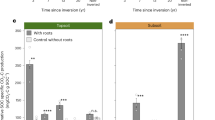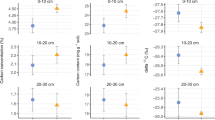Abstract
The sensitivity of soil organic carbon (SOC) to changing environmental conditions represents a critical uncertainty in coupled carbon cycle–climate models1. Much of this uncertainty arises from our limited understanding of the extent to which root–microbe interactions induce SOC losses (through accelerated decomposition or ‘priming’2) or indirectly promote SOC gains (via ‘protection’ through interactions with mineral particles3,4). We developed a new SOC model to examine priming and protection responses to rising atmospheric CO2. The model captured disparate SOC responses at two temperate free-air CO2 enrichment (FACE) experiments. We show that stabilization of ‘new’ carbon in protected SOC pools may equal or exceed microbial priming of ‘old’ SOC in ecosystems with readily decomposable litter and high clay content (for example, Oak Ridge5). In contrast, carbon losses induced through priming dominate the net SOC response in ecosystems with more resistant litters and lower clay content (for example, Duke6). The SOC model was fully integrated into a global terrestrial carbon cycle model to run global simulations of elevated CO2 effects. Although protected carbon provides an important constraint on priming effects, priming nonetheless reduced SOC storage in the majority of terrestrial areas, partially counterbalancing SOC gains from enhanced ecosystem productivity.
This is a preview of subscription content, access via your institution
Access options
Subscribe to this journal
Receive 12 print issues and online access
$209.00 per year
only $17.42 per issue
Buy this article
- Purchase on Springer Link
- Instant access to full article PDF
Prices may be subject to local taxes which are calculated during checkout



Similar content being viewed by others
References
Todd-Brown, K. E. O., Hopkins, F. M., Kivlin, S. N., Talbot, J. M. & Allison, S. D. A framework for representing microbial decomposition in coupled climate models. Biogeochemistry 109, 19–33 (2011).
Kuzyakov, Y. Priming effects: Interactions between living and dead organic matter. Soil Biol. Biochem. 42, 1363–1371 (2010).
Cotrufo, M. F., Wallenstein, M. D., Boot, C. M., Denef, K. & Paul, E. A. The Microbial Efficiency-Matrix Stabilization (MEMS) framework integrates plant litter decomposition with soil organic matter stabilization: Do labile plant inputs form stable soil organic matter? Glob. Change Biol. 19, 988–995 (2013).
Von Lützow, M. et al. Stabilization of organic matter in temperate soils: Mechanisms and their relevance under different soil conditions—a review. Eur. J. Soil Sci. 57, 426–445 (2006).
Jastrow, J. D. et al. Elevated atmospheric carbon dioxide increases soil carbon. Glob. Change Biol. 11, 2057–2064 (2005).
Drake, J. E. et al. Increases in the flux of carbon belowground stimulate nitrogen uptake and sustain the long-term enhancement of forest productivity under elevated CO2 . Ecol. Lett. 14, 349–357 (2011).
Fischlin, A. et al. in Climate Change 2007: Impacts, Adaptation and Vulnerability (eds Parry, M. L., Canziani, O. F., Palutikof, J. P., van der Linden, P. J. & Hanson, C. E.) 211–272 (IPCC, Cambridge Univ. Press, 2007).
Denman, K. et al. in Climate Change 2007: The Physical Science Basis (eds Solomon, S. et al.) 499–587 (IPCC, Cambridge Univ. Press, 2007).
Carney, K. M., Hungate, B. A., Drake, B. G. & Megonigal, J. P. Altered soil microbial community at elevated CO2 leads to loss of soil carbon. Proc. Natl Acad. Sci. USA 104, 4990–4995 (2007).
Panikov, N. Understanding and prediction of soil microbial community dynamics under global change. Appl. Soil Ecol. 11, 161–176 (1999).
Schmidt, M. W. I. et al. Persistence of soil organic matter as an ecosystem property. Nature 478, 49–56 (2011).
Wieder, W. R., Bonan, G. B. & Allison, S. D. Global soil carbon projections are improved by modelling microbial processes. Nature Clim. Change 3, 909–912 (2013).
Norby, R. J. & Zak, D. R. Ecological lessons from Free-Air CO2 Enrichment (FACE) experiments. Annu. Rev. Ecol. Evol. Syst. 42, 181–203 (2011).
Phillips, R. P., Finzi, A. C. & Bernhardt, E. S. Enhanced root exudation induces microbial feedbacks to N cycling in a pine forest under long-term CO2 fumigation. Ecol. Lett. 14, 187–194 (2011).
Talhelm, A. F., Pregitzer, K. S. & Zak, D. R. Species-specific responses to atmospheric carbon dioxide and tropospheric ozone mediate changes in soil carbon. Ecol. Lett. 12, 1219–1228 (2009).
Hoosbeek, M. R. More new carbon in the mineral soil of a poplar plantation under Free Air Carbon Enrichment (POPFACE): Cause of increased priming effect? Glob. Biogeochem. Cycles 18, GB1040 (2004).
Van Groenigen, K-J., Qi, X., Osenberg, C. W., Luo, Y. & Hungate, B. A. Faster decomposition under increased atmospheric CO2 limits soil carbon storage. Science 344, 508–509 (2014).
Zaehle, S. et al. Evaluation of 11 terrestrial carbon–nitrogen cycle models against observations from two temperate Free-Air CO2 Enrichment studies. New Phytol. 202, 803–822 (2014).
Cheng, W. et al. Synthesis and modeling perspectives of rhizosphere priming. New Phytol. 201, 31–44 (2014).
Foereid, B., Ward, D. S., Mahowald, N., Paterson, E. & Lehmann, J. The sensitivity of carbon turnover in the Community Land Model to modified assumptions about soil processes. Earth Syst. Dynam. 5, 211–221 (2014).
Davidson, E. A. & Janssens, I. A. Temperature sensitivity of soil carbon decomposition and feedbacks to climate change. Nature 440, 165–173 (2006).
Lichter, J. et al. Soil carbon sequestration and turnover in a pine forest after six years of atmospheric CO2 enrichment. Ecology 86, 1835–1847 (2005).
Norby, R. J., Warren, J. M., Iversen, C. M., Medlyn, B. E. & McMurtrie, R. E. CO2 enhancement of forest productivity constrained by limited nitrogen availability. Proc. Natl Acad. Sci. USA 107, 19368–19373 (2010).
Shevliakova, E. et al. Carbon cycling under 300 years of land use change: Importance of the secondary vegetation sink. Glob. Biogeochem. Cycles 23, GB2022 (2009).
Milly, P. C. D. et al. An enhanced model of land water and energy for global hydrologic and earth-system studies. J. Hydrometeorol. 15, 1739–1761 (2014).
Six, J., Elliott, E. & Paustian, K. Soil macroaggregate turnover and microaggregate formation: A mechanism for C sequestration under no-tillage agriculture. Soil Biol. Biochem. 32, 2099–2103 (2000).
Wu, J., Brookes, P. C. & Jenkinson, D. S. Formation and destruction of microbial biomass during the decomposition of glucose and ryegrass in soil. Soil Biol. Biochem. 25, 1435–1441 (1993).
Dunne, J. P. et al. GFDL’s ESM2 global coupled climate–carbon earth system models. Part I: Physical formulation and baseline simulation characteristics. J. Clim. 25, 6646–6665 (2012).
Acknowledgements
Thanks to E. Brzostek and M. Midgley for helpful comments on the manuscript and to S. Malyshev for providing the high-frequency GFDL ESM forcing. B.N.S., E.S. and S.W.P. acknowledge support in parts from the NOAA (US Department of Commerce) grant NA08OAR4320752, the USDA grant 2011-67003-30373 and the Carbon Mitigation Initiative at Princeton University, sponsored by BP. The statements, findings and conclusions are those of the authors and do not necessarily reflect the views of the NOAA, the US Department of Commerce, the US Department of Agriculture, or BP.
Author information
Authors and Affiliations
Contributions
B.N.S. developed the model, designed and conducted experiments, analysed the data, and wrote the paper. E.S. and S.W.P. contributed to model development and experimental design and helped write the paper. R.P.P. and A.C.O. contributed data and expertise for set-up and interpretation of site-level simulations, and helped write the paper.
Corresponding author
Ethics declarations
Competing interests
The authors declare no competing financial interests.
Supplementary information
Rights and permissions
About this article
Cite this article
Sulman, B., Phillips, R., Oishi, A. et al. Microbe-driven turnover offsets mineral-mediated storage of soil carbon under elevated CO2. Nature Clim Change 4, 1099–1102 (2014). https://doi.org/10.1038/nclimate2436
Received:
Accepted:
Published:
Issue Date:
DOI: https://doi.org/10.1038/nclimate2436
This article is cited by
-
Enhanced future vegetation growth with elevated carbon dioxide concentrations could increase fire activity
Communications Earth & Environment (2024)
-
Projected soil carbon loss with warming in constrained Earth system models
Nature Communications (2024)
-
Mycorrhizal type regulates trade-offs between plant and soil carbon in forests
Nature Climate Change (2024)
-
How to adequately represent biological processes in modeling multifunctionality of arable soils
Biology and Fertility of Soils (2024)
-
Grassland responses to elevated CO2 determined by plant–microbe competition for phosphorus
Nature Geoscience (2023)



